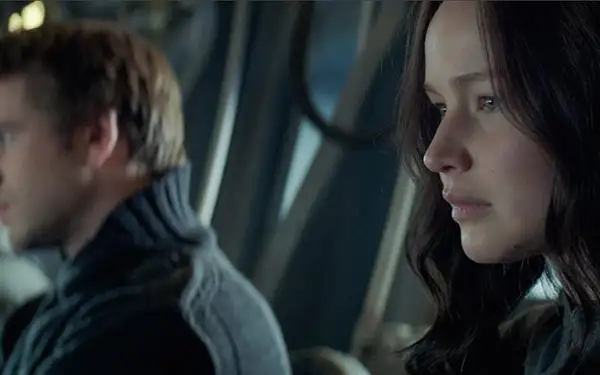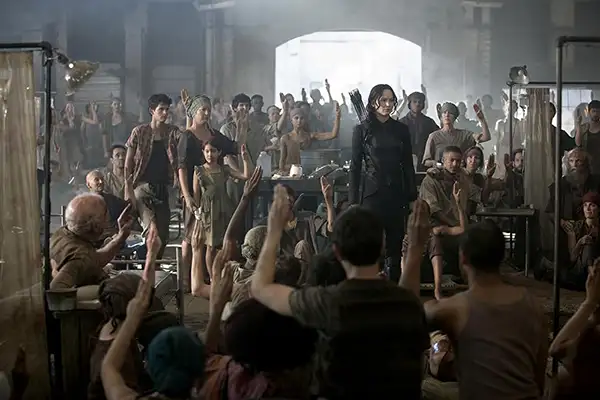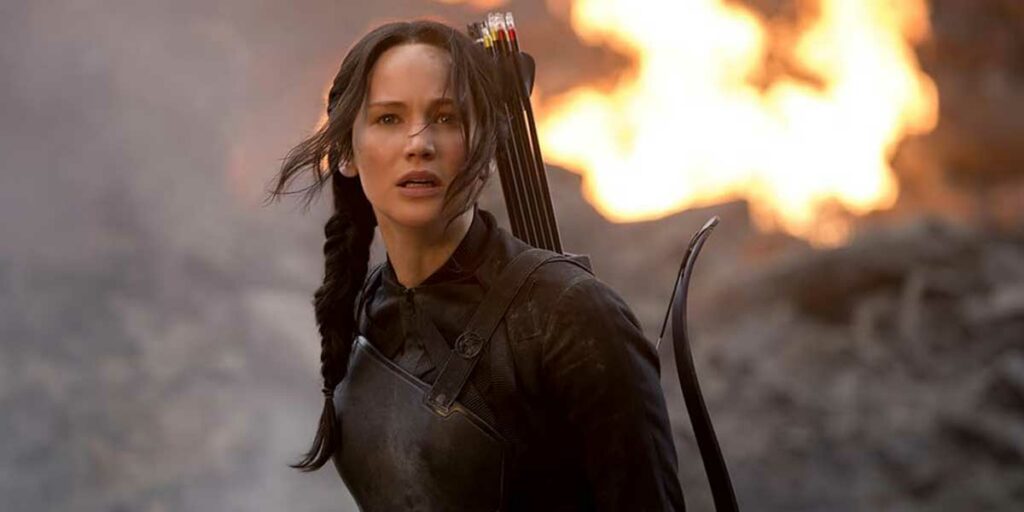The Hunger Games: Mockingjay Part 1 trades the action of the titular games for a dark, tense political thriller that’s just as relevant now as it’s ever been.
The Hunger Games: Mockingjay Part 1 was released in 2014 and is the third film in the Hunger Games series. The original book trilogy by Suzanne Collins was adapted into four films in the 2010s, with the third book being split into two parts when heading for the big screen. Katniss Everdeen (Jennifer Lawrence) has just learned that Panem’s District 12 is destroyed and her friend Peeta (Josh Hutcherson) is being held prisoner in the Capitol. She joins with a rebellion that’s headed by Alma Coin (Julianne Moore) and dubbed the “Mockingjay,” a symbol of hope for Panem and a bird I wish was real. From there, she’s put through a series of political campaigns and propaganda meant to further fan the flames of rebellion, while the Capitol and President Snow (Donald Sutherland) use Peeta to similarly keep the hearts and minds of the country under control.
We all remember when young adult novel-to-film adaptations seemed to pop up everywhere in the late 2000s and 2010s. We saw Harry Potter, Twilight, Divergent, and Percy Jackson all be adapted to big screen, to varied reception. The Harry Potter film series still seems to get praise when its creator doesn’t talk, the Twilight movies were panned and spawned Fifty Shades of Grey (a novel that felt like it was written by a young adult), and the Divergent movies … exist, I think. But whether the buzz was good or bad, this “genre” of film never grabbed me, even when I was squarely within the target demographic. That is, except for The Hunger Games. So, with a prequel to the series about to come out, I revisited these two films in particular to see how they hold up, starting with Mockingjay Part 1.
In terms of plot, what I’ve described is pretty much all there is to Mockingjay Part 1 … which, for many, is the biggest problem with the film. I’d be lying if I said I didn’t, to some degree, agree. The structure of Mockingjay Part 1’s story doesn’t have a tangible sense of rising or falling action. It’s not a random series of unimportant events, but the fact that the events aren’t really building toany concrete conclusion makes the film start to feel meandering after a while. It’s not that there’s no narrative flow from one scene to the next; it’s that there’s no feeling of any narrative flow, because that flow is taking us around almost in circles while very slowly moving us forward. Katniss herself doesn’t do much or have any major growth, which helps contribute to the filler vibe. Mockingjay is a book that was split into two films, and as many have pointed out, that shows.
But at the same time, when I look through the plot of Mockingjay Part 1 and think of what should have been cut or even just shortened … I really can’t find much. Maybe a sequence where the rebellion’s underground base is under attack, or one or two mood-building scenes, but not nearly enough to justify making Mockingjay just one movie. Unless you’d be fine with its runtime being three and a half hours long. (Maybe if Scorsese directed it, that would suddenly be seen as genius.) Pretty much everything that happens in Mockingjay Part 1 either sets the stage for the next major event or provides character- and world-building bits whose omissions would’ve made the film lesser.

Katniss reacts to what happened in the previous film (Catching Fire), and the rebellion points that reaction in the direction they want. This escalates the Capitol’s retaliations, which escalates the rebellion’s counter propaganda, which pushes Peeta past his breaking point, which leads to time for him running out, which leads to a rescue mission in the film’s climax … really, there’s very little in here that I would classify as unnecessary to moving the story of the whole series forward in some way.
But even if someone accepted that, they may be more hard-pressed to accept how slowly the story moves. For many people, that’s a con of the movie; for me, it’s an asset. Francis Lawrence, who’s unrelated to Jennifer Lawrence unless you want to believe some conspiracy theory, is a very underrated director whose touch is a crucial part of this film franchise’s identity. He directed every film except the first one and, through meticulous pacing and editing, gave the series the uncomfortable weight it deserves. Mockingjay Part 1 is not an action movie; it’s a political thriller. And it’s a really exceptionally well-crafted political thriller.
The way cinematographer Jo Willems slowly tracks each character as they walk into either a large-scale hellscape or desolate shelter makes you feel like you’re right there with them. Every character’s reaction is shown through tight and efficient staging, especially during the most emotional, confrontation-driven scenes in which the camera tightens in on the people involved. A huge majority of the film plays out in uncomfortable silence with very minimal use of a score. Considering James Newton Howard did the music, it’s tempting to call this the worst film of all time for not making prominent use of one of the best film composers ever. But the choice really benefits the grim atmosphere.
The lack of music also highlights how unbelievably pitch-perfect every performance is. Jennifer Lawrence is excellent in all of these movies, and she’s naturally given the most material to work with as her character is torn between following her heart, following the orders of those she’s supposed to trust, reluctance to being a symbol, and having the fire of that symbol be brought out. But everyone else matches her prowess, which is no surprise when the cast includes acting greats like Julianne Moore, Jeffrey Wright, Woody Harrelson, Donald Sutherland, and the posthumous Phillip Seymour Hoffman.
Even characters who aren’t written that interestingly, like former Hunger Games winner Finnick Odair (Sam Claflin), are made so much more interesting just through the actors’ authentic performances. Josh Hutcherson’s performance is but a taste of what he’d get to do in Mockingjay Part 2, but he still has to juggle his character’s sincere feelings with the façade he’s been forced into, with the possibility that he’s trying to physically convey what he really feels to the rebels, while making it convincing enough for the Capitol to buy it.
That’s just one of the many layers going on with the narrative of Mockingjay Part 1. The Hunger Games as a series is best known for … well, the Hunger Games, the life-or-death competition that lends itself towards action and spectacle. But for me, the beating heart of these movies is the sociopolitical intrigue going on under the surface. The first film keeps things generally basic to focus on the game aspect, but Catching Fire really delves into the aftermath and Katniss’s struggle to play the celebrity for Snow and the Capitol. Mockingjay Part 1 takes these subjects to another level because now, instead of needing to survive under the manipulation of her enemy, Katniss has to deal with the manipulation of her allies.

Mockingjay Part 1 introduces a sour pill to swallow: in a world where power lies with those who can best manipulate the masses, even the rebels whom we’re rooting for must resort to manipulation. Katniss may be the face of the revolution, but she’s not the brain. She’s not in charge, nor does she make the big decisions, because even on her side, she’s not the one in power. She’s the one being exploited. It’s exploitation for a good cause, but it’s exploitation nonetheless. Even when Katniss is taken to spread hope to a hospital full of injured citizens, it’s not just for them. It’s also a publicity opportunity to gain allies. She’s clearly seen as a means to an end by many, especially Coin, who’s even more fascinating to watch with the hindsight of knowing where Part 2 goes. And, of course, the Capitol ups its own manipulative tactics, warping everything into their own narrative and even mimicking the rebellion’s method of putting a face (Peeta’s) to their cause.
Mockingjay Part 1 doesn’t contain much action because it’s not a story about physical altercations. It’s about psychological warfare on both sides, so that’s what we see. It would have been so much easier to make this a more triumphant, rousing story of the good rebels gaining support and tyranny beginning to crumble, but both the book and this film are clearly interested in going deeper than that. They don’t want to show Katniss as just a brave hero, but also someone with her own desires, fears, and anger that sometimes work to the cause’s favor and sometimes don’t. She has to keep grappling with how much of her own agency she needs to give up to save her country, and how much she can’t give up.
The comparisons and parallels you could make to our own reality are endless, from a political, social, and even entertainment perspective. It’s why I try to never look at any one side or individual in politics as “the good guy,” even if I’m on their side. I know the evils and dangers of something like the Trump campaign of the past and even, inexplicably, the present, and I stand wholeheartedly against it. But that doesn’t mean I see the left as heroes or the ones who really have our best interests at heart. They must be resorting to sneaky, probably even dirty, tricks to get and maintain power. They’re just doing it in service of something I agree more closely on.
We’ve lived in a world where so many people want to hold politicians and celebrities up as great, wonderful individuals and idols. Entertainment bigshots are “stanned.” Social media users create their personas, working the system and its users to their own benefit. As I try to be far more active on Twitter (I refuse to call it what Elon wants me to call it), I’m altering the way I would otherwise communicate with people for the sake of gaining followers and attention. It’s soul-crushing and demeaning, but I know it’s what I have to do. I admired how Mockingjay Part 1 inspired these types of thoughts in me back when it first came out, and I’ve grown substantially more grateful for the film’s commentary in the nine harrowing years since then.
Mockingjay Part 1 is not a flawless story from start to finish, and it starts to sag a little bit towards the endgame, but I still love it for taking the unexpected route of a slow-burn political thriller that dives deeper into the power of intellectual and media-driven warfare. I completely understand why a lot of people don’t like the film that much, and I don’t blame them for feeling that it’s an incomplete story. But if your only real gripe is that it doesn’t have much action, maybe think about whether the Hunger Games themselves have been the distraction from something more meaningful.
The Hunger Games: Mockingjay Part 1 is now available to watch on digital and on demand. Read our review of The Hunger Games: The Ballad of Songbirds and Snakes.

